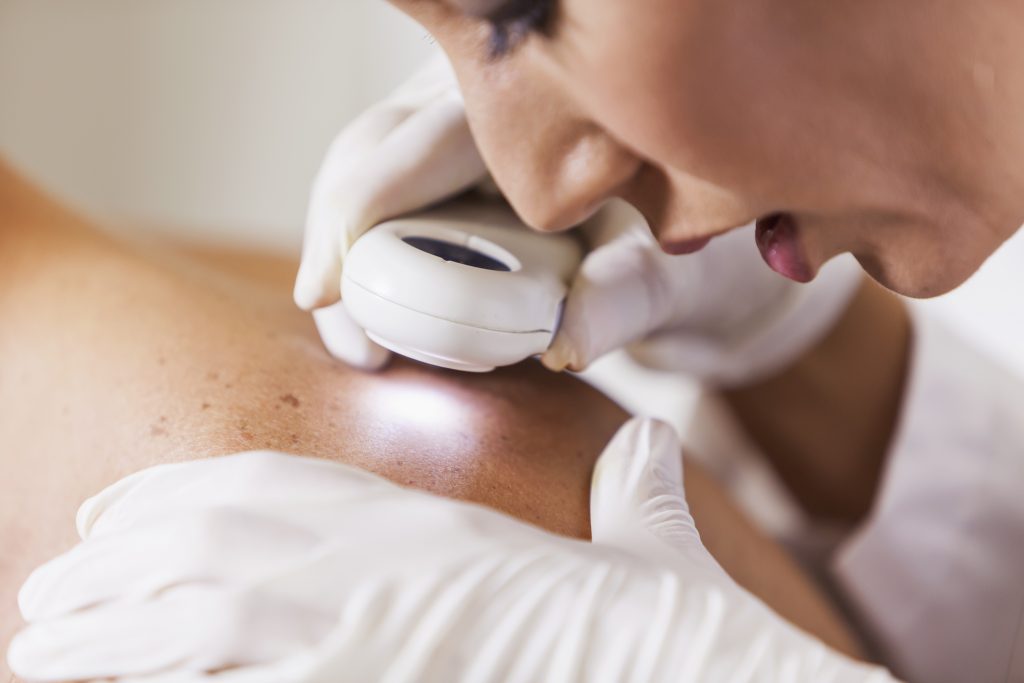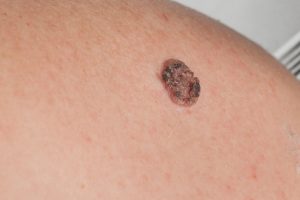Squamous Cell Carcinoma Treatments from U.S. Dermatology Partners
What Is Squamous Cell Carcinoma?
Squamous Cell Carcinoma is a common form of skin cancer that develops in the squamous cells that make up the outer layer of the skin. Although it is usually not life-threatening, it can be aggressive in some cases.
If left untreated, squamous cell carcinoma can grow large or spread to other parts of your body, causing serious complications.

Your dermatologist will be able to examine your skin for signs of squamous cell carcinoma.
Find This Service Near You
Who Is at Risk for Squamous Cell Carcinoma?
More than 90 percent of all skin cancer is caused by long-term exposure to UV radiation.
Squamous cell carcinoma is more common in people who use tanning beds, have fair skin and light-colored eyes, have a history of skin cancer or precancerous lesions, or have a weakened immune system because of an underlying condition or the use of immunosuppresant therapies like chemotherapy.
Additionally, people with a history of sunburns or those who spend an excessive amount of time in the sun are also at greater risk.
Squamous Cell Carcinoma Symptoms

Squamous cell cancer can keratinize and blacken.
Squamous cell carcinoma is most likely to be found on an area that is exposed to the sun — such as your scalp, arms, back of the hands, ears or lips. However, it can also occur in areas such as inside your mouth, on your anus and on your genitals.
Distinguishing marks of squamous cell carcinoma could include:
- A firm, red nodule
- A flat sore with a scaly crust
- A new sore or raised area on an old scar or ulcer
- A rough, scaly patch on your lip that may grow into an open sore
- A red sore or rough patch inside your mouth
- A red, raised patch or wart-like sore on or in the anus or on your genitals
Squamous Cell Carcinoma Treatments
Most squamous cell carcinomas can be removed with relatively minor surgery or occasionally with a topical medication. Different types of surgical procedures include:
- Cryosurgery, in which the lesion is frozen with liquid nitrogen
- Curettage, in which the skin cancer is removed by scraping the area with a sharp looped-edged instrument called a curette. The cancerous area is then treated with an electrocautery needle to destroy any remaining cancer cells and help control bleeding. This process may be repeated a few times with a deeper layer of tissue being scraped and cauterized each time to help destroy all of the cancer cells.
- Simple excision, in which the cancerous tissue and some surrounding healthy skin is cut out.
- Mohs surgery. This is a procedure in which your doctor removes the cancer layer by layer and examines each layer under the microscope until no abnormal cells remain.
- Radiation therapy, which uses high-energy beams such as X-rays to kill cancer cells. This is more common for deeper tumors.
Squamous Cell Carcinoma Prevention

Wearing a hat and applying sunscreen regularly can help protect your skin.
Although treatments are very successful when skin cancer is caught early, the best way to prevent skin cancer is to protect your skin from sunlight. Make smart sun habits a part of your daily healthcare regimen.
- Limit the amount of time spent outdoors during peak sun hours (10:00 AM to 4:00 PM).
- Avoid tanning booths and sunburn.
- Wear a broad spectrum (UVA/UVB) sunscreen with an SPF of 15+ every day.
- For extended outdoor activity, use a water-resistant, broad spectrum sunscreen with an SPF of 30+.
- When outside, cover-up with long pants, a long-sleeved shirt, a broad-brimmed hat and UV-blocking sunglasses.
- Check your skin head-to-toe every month.
- See your dermatologist every year for an annual skin examination.
- See Also
- Skin Cancer
- Actinic Keratosis
- Annual Skin Examinations
- Basal Cell Carcinoma
- Cryotherapy
- Melanoma
- Mohs Surgery
- Squamous Cell Carcinoma
- Sunscreen
*Results may vary by individual

